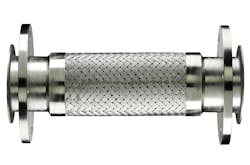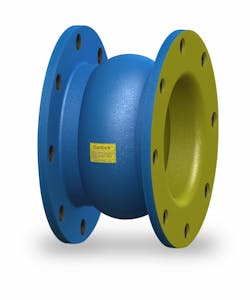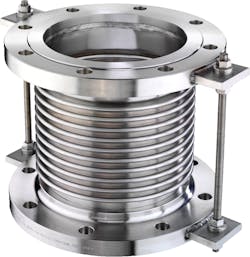How to strengthen your weakest link and save costs
Just as the name implies, expansion joints allow for linear and some angular movement in a pipeline or connection to a pump or piece of equipment. By design, they are the forgiving replaceable links in the system to protect pipelines and equipment. Depending on the type you choose, they have many other attributes.
Some industries that benefit from proper expansion joint selection and use are:
- Dredging (with ABS standing-type class approval)
- Chemical processing
- Power generation
- Pulp and paper, gypsum
Miles upon miles of heavy-duty, long-lasting metal piping structures and pumps are used by numerous plants and need service. Most should be connected with expendable rubber, fiber, PTFE (polytetrafluoroethylene) or metal expansion joints.
There are many different types of expansion joints for the thousands of service applications out there, and the primary requirement for all is the necessary movement capabilities.
Expansion joints protect infrastructure and can be easily replaced compared to piping or pumps. They are also less expensive than the structure and pumps’ costs, replacement costs, and downtime.
Expansion joints are one of the toughest, longest-lasting expendable products you can use if chosen properly. I have personally observed this specific case: 12″ rubber expansion joints holding up huge stock pumps, couplings and motor skids because the caustic environment eroded the concrete base for the pump skid. Three pump skids in a row, all hanging by the expansion joints, for over a year — it was a challenge to repair.
Unfortunately, most expansion joint needs occur when one has failed, and the end user needs one ASAP to avoid downtime. Some end users will desperately take whatever is available with quick delivery, even though the better choice of an engineer-designed expansion joint would pay off. Also, they might only buy one size of the expansion joint needed to fit the current hard-piped space. Many are too long and are compressed or even stretched to fit in the space, which is detrimental to the life, service conditions, media, temperature, pressure and, most of all, actual movements required. After all, it is an expansion joint, implying it can handle movement.
Choosing expansion joints
To choose the proper expansion joints, we can use the industry standard acronym S.T.A.M.P.:
Size: What are the shape, diameter and length, bolting (flange size class, i.e., 150#–300#), ANSI or DIN bolting patterns, concentric or eccentric size reduction end? Most manufacturers embed manufacturing information on the cover of their expansion joints, such as style, material and a serial or identifying number.
Temperature: Is the temperature constant or cycling? Is the inside of the expansion joint completely submerged by media? Is the inside cleaned with high-temperature steam?
Application: Determine if the application is piping, pump, valve, heat exchanger, metallic or non-metallic flanges, raised-face or flat-face flanges, backing flanges, movement requirements (elongation, compression, misalignment, flange rotation), cycling movements, moment control bars, abrasion liner, etc. Consult an expansion joint application sheet. *Note: Manufacturers recommend against mounting a flat-face expansion joint to a raised-face flange without some type of spacer/shim to prevent expansion joint flange rotation. It damages the expansion joint.
Media: Is the media liquid, solid, abrasion material, or a chemical concentration? Are other cleanout or service chemicals used? Do external media and environments (e.g., chemicals, sunlight or steam) create rubber-deteriorating ozone?
Pressure: Are the pressures constant or cycling? What are the flow rates (GPM)? (Rubber’s flow rate capabilities are much less than steel, especially with abrasion materials involved.) Is it a closed-system maximum pressure, including external environmental temperatures?
Expansion joint styles
Round rubber expansion joints are the most popular by volume. They are used in all types of pipe flanged connections and are manufactured with many different rubber, PTFE and other compounds. As the name implies, their main purpose is to handle elongation, compression, lateral movement and vibration.
The industry has standard lengths for different sizes of expansion joints, but nonstandard specialty lengths are available. There are also many kinds of round rubber expansion joints. Manufacturing arches in the expansion joint’s body allow necessary movement by compressing or elongating the arch. Some arches have an abrupt style; some have bigger radiuses or a flowing style (Figure 1). The flowing arches are considered less clog-prone and retain their movement better.
The body of the expansion joints and the liner conveying the media are usually made of different materials. The body is generally made of weather- and ozone-resistant rubber. The liner uses different chemical- or abrasion-resistant rubber compounds, PTFE or other materials as needed for the service application.
Below are some basic styles and subcategories of expansion joints.
- Round PTFE piping expansion joints: This widely used expansion joint is PTFE-molded with convolutions for the movement needed. They can also be machined and designed to handle more movement than a rubber expansion joint. But without an outer body, these expansion joints must have external control-type rods for reinforcement. The PTFE bellows are generally flared over compatible flanges so that all wetted parts only see the PTFE for the chemical resistance needed. The industry has standard lengths for different sizes of expansion joints, but nonstandard specialty lengths are available from production.
- Round rubber piping joints: Another type of expansion joint or just a pipe connection sleeve is often used in repair applications but can be an original design. This type is generally nonstandard and made to order. Some on-the-shelf items are available that wrap over and around the pipe for quick repair sleeves. These are generally a lower-pressure and less-critical media application.
- Round metal expansion joint: Metal expansion joints (Figure 2) are generally used where temperatures exceed rubber and PTFE expansion joint capabilities. They can be made of layers of metal, increasing the flexibility of the expansion joint by using thinner, layered metals. The layering can also warn of leaks by installing a test point or a weep hole to notify the user when to replace the expansion joint.
These metal expansion joints are generally nonstandard sizes and lengths, made to order but can be fabricated quickly. One of the primary uses of a metal-layered expansion joint is on exhaust systems, such as large diesel engines. They are preferred in these applications because of their heat-, movement- and vibration-deadening capabilities. Large engines create a lot of vibration that transfers through the connected system and damages the engine and connected parts. The multiple layers of metal making up the expansion joint absorb and deaden the vibration. Special high-temperature gasketing that handles the vibration is also needed.
Note that a metal assembly with a wire braid on the cover is not an expansion joint. It is a metal hose (Figure 3) without any elongation and compression movement capabilities. This is a common mistake in the industry — a true metal expansion joint will have no wire braid on its cover.
Once you have completed your S.T.A.M.P. selection process, consider that almost all expansion joint applications have abrasion or internal-wear issues. Even in clean liquid processing, scale from the piping and equipment plus the GPM wear the expansion joint’s liner. In heavy solids with high abrasion, the issue increases tenfold.
Other ways to help choose the proper expansion joints
Try using handmade expansion joints. They can be constructed for your needs with stronger, more suitable material, and greater precision and strength support. Molded expansion joints have their place but are better for high-volume production and used for very general services. Some also have limitations on the materials used in the construction.
In the past, the industry used natural gum or rubber for abrasion resistance. New materials in the industry — like millable polyurethane liner material (Figure 1) — have increased the wear life of expansion joints. On a test stand, using the American Society for Testing and Materials (ASTM) D2228 abrasion test, the millable polyurethane liner lasts two to three times longer than traditional gum materials. This series of expansion joints also has yellow liner material to alert the end user on a visual inspection when it is worn down to the expansion joint’s carcass, indicating it is time to replace it.
Have an expansion joint survey done — qualified suppliers and manufacturers conduct surveys. A survey will identify:
- Issues like leaks. Expansion joints tend to have slow leaks through the layers of construction, warning the end user to replace them.
- Nonstandard-length expansion joints that have long deliveries and extra costs. Correcting these nonstandard opening lengths will greatly reduce issues and expenses.
- Problems including misalignment, offsets, flange rotation, overextension and over-compression. All of these shorten expansion joint life expectancy.
- Applications where an expansion joint should be or a current joint is not working. In the case of no expansion joint on a pump-to-piping application, stress fractures in the flange connection casing of the pump and the support legs are common. The pump’s vibrational frequency is transmitted through the connecting pipe. At the first turn or obstruction in the pipe, that vibration returns to the pump and causes stress fractures in the pump casing (especially around the connection flange). The vibration can damage bearings and even the mechanical seal operation of the pump. A proper expansion joint can stop these issues.
In perspective, why not use the best and longest-lasting expansion joint to protect your expensive piping systems and pump applications? Downtime alone could be reduced by three times, making it worth the initial investment.
Based in Mobile, Alabama, Jeff Arnold is the director of Mi Conveyance Solutions’ Gasket and Sealing Group and a Hose Specialist. Working with applications across the industry, he has multiple certifications and 45 years of field experience in gasketing; sealing; expansion joints; pump/valve packing; and hose, rubber, conveyor belting, and high-temp products. For more information, visit www.MiConveyanceSolutions.com.


